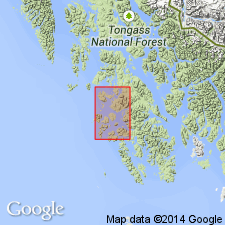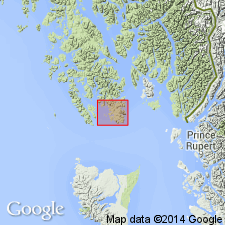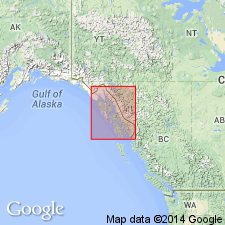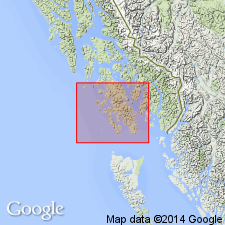
- Usage in publication:
-
- Karheen Formation*
- Modifications:
-
- Named
- Biostratigraphic dating
- Dominant lithology:
-
- Graywacke
- AAPG geologic province:
-
- Alaska Southeastern region
Summary:
Unit is named the Karheen Formation. Consists of green-gray, gray and reddish-brown lithic wacke and graywacke. Present in minor amounts are siltstone, red, red-brown, and green shale, thin-bedded sandy limestone, contorted platy limestone, pebble-to-cobble, polymictic conglomerate and biostromal limestone and reef breccia. Most of sandstone is medium- to fine-grained, and is carbonate cemented. Thickness is greater than 6000 ft. Conformably overlies Heceta Limestone (new) or unconformably overlies the Descon Formation (new). Conformably underlies the Wadleigh Limestone (new). Age is Late Silurian to Early Devonian based on fossils [corals, graptolites, stromatoporoids and crinoids].
Source: GNU records (USGS DDS-6; Menlo GNULEX).

- Usage in publication:
-
- Karheen Formation*
- Modifications:
-
- Areal extent
- Age modified
- AAPG geologic province:
-
- Alaska Southeastern region
Summary:
A sequence of rocks consisting of conglomerate at base; sandstone, siltstone, and limestone in middle; and in northern part of area, laminated mudstone and black shale in upper part are correlated with Karheen Formation. Geographically extended to southern Prince of Wales Island [54 deg 45'N to 55 deg N, and 132 deg W to 132 deg 22'W]. Includes plagioclase-porphyritic dacite(?) and microporphyritic basaltic-andesitic volcanic and hypabyssal rocks which are not recognized to north. Age is Early Devonian.
Source: GNU records (USGS DDS-6; Menlo GNULEX).

- Usage in publication:
-
- Karheen Formation*
- Modifications:
-
- Age modified
- AAPG geologic province:
-
- Alaska Southeastern region
Summary:
Age of the Karheen Formation is Early Devonian based on conodonts (Savage, 1977). Lowermost one m of unit is richly fossiliferous and has yielded conodonts indicative of earliest Devonian (early Lochkovian) age. [report cites Open-File Report 83-91 of Eberlein and others, 1983.]
Source: GNU records (USGS DDS-6; Menlo GNULEX).

- Usage in publication:
-
- Karheen Formation*
- Modifications:
-
- Age modified
- Biostratigraphic dating
- AAPG geologic province:
-
- Alaska Southeastern region
Summary:
Age of the Karheen Formation is revised from Early Devonian to: Early and Middle(?) Devonian (everywhere) based on fossils [graptolites and shelly fossils].
Source: GNU records (USGS DDS-6; Menlo GNULEX).
For more information, please contact Nancy Stamm, Geologic Names Committee Secretary.
Asterisk (*) indicates published by U.S. Geological Survey authors.
"No current usage" (†) implies that a name has been abandoned or has fallen into disuse. Former usage and, if known, replacement name given in parentheses ( ).
Slash (/) indicates name conflicts with nomenclatural guidelines (CSN, 1933; ACSN, 1961, 1970; NACSN, 1983, 2005, 2021). May be explained within brackets ([ ]).

